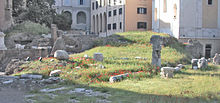Temple of Bellona, Rome
 The Temple podium | |
 Click on the map for a fullscreen view | |
| Coordinates | 41°53′33″N 12°28′48″E / 41.8924°N 12.4799°E |
|---|---|
The Temple of Bellona was a
History
It was first vowed in 296 BC by
The temple is depicted in the Forma Urbis Romae of the 3rd century.
Archeology
The temple – long considered lost – was identified with the remains of a
These podium remains are made up of the cement infill between the load-bearing structures. (Those structures were constructed from
The surviving remains and plan of the temple on the
The Columna Bellica
In front of the temple was a column used in the archaic Roman ceremony for declaring war involved hurling a spear from Roman territory towards enemy territory. However, when for the first time Rome had to declare war on a state whose territory did not border her own (i.e. Pyrrhus of Epirus), it was hard to see how this rite could be carried out. A prisoner of war was therefore forced to hold a small piece of land in the area of the circus Flaminius, where a column was raised (perhaps in wood) as a symbolical representation of the hostile territory and a spear then hurled against the column. This new procedure was then used on all subsequent occasions (the last well-known example is in 179 AD, under Marcus Aurelius).
A circular area with the paving restored in front of this temple was interpreted in the excavations as the place where this column was sited, on the basis of literary references. This is now interpreted as where the perirrhanterion (for lustrali at the end of campaigns) was sited before the temple of Apollo was built.
See also
- Temple of Bellona (Ostia)
- List of Ancient Roman temples
External links
- S.Platner and T.Ashby, A Topographical Dictionary of Ancient Rome, 1929
- Plans of the Apollo and Bellona temples on the Comune di Roma site here and here
- The Roman ceremony of the declaration of war (Italian)

